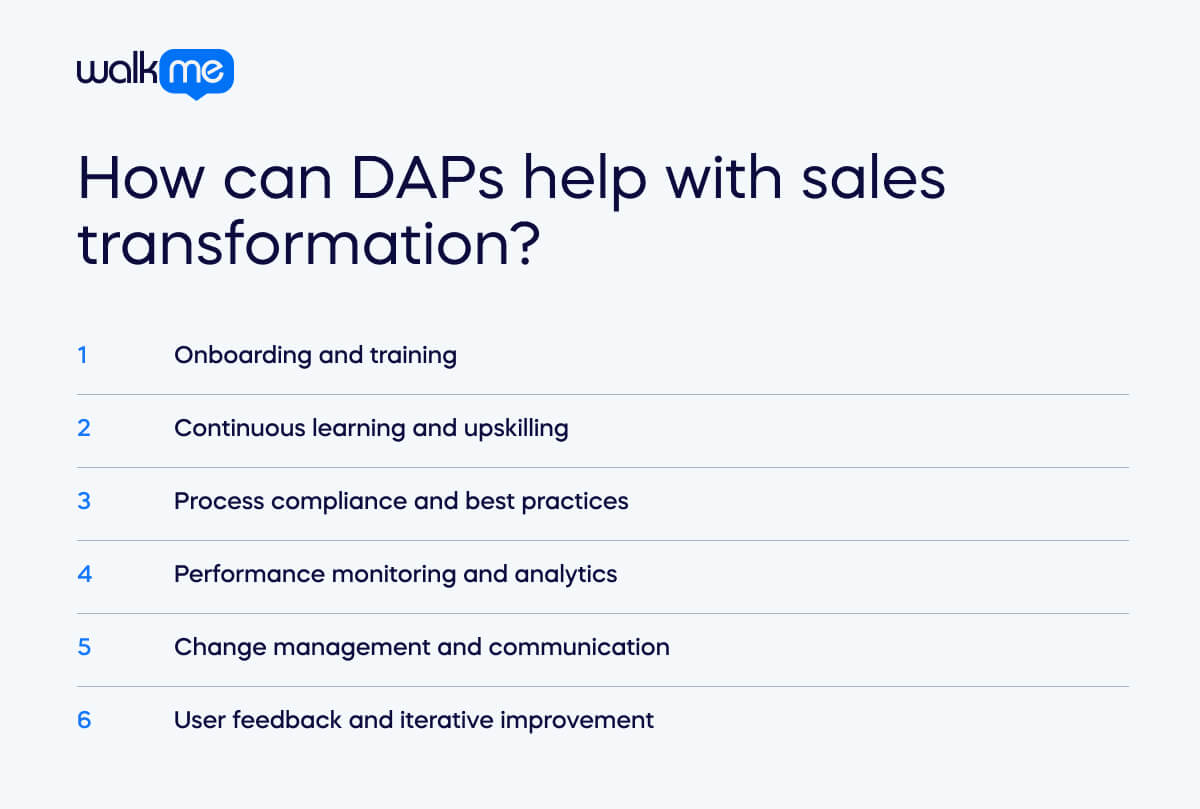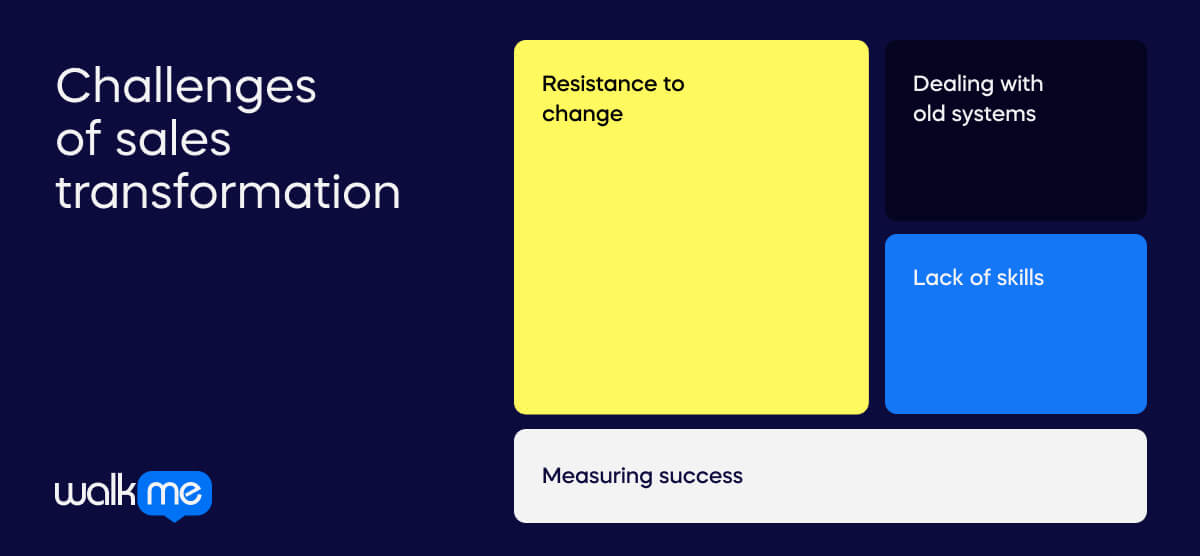What is sales transformation?
Sales transformation means changing how a company sells its products or services. This includes updating strategies, processes, technology, and culture to keep up with customers’ wants and how the market changes.

Table of contents
It’s about finding better ways to make money, work more efficiently, and keep customers happy. For example, Salesforce reveals that 73% of customers expect improved personalization as technology advances. Furthermore, research shows that 80% of customers believe their experience with a company is just as important as its products and services. This highlights the importance of effective sales transformation, especially for companies who want to keep up with customer expectations. Here are the main parts of sales transformation:
Strategy: Figuring out the best way to sell matches what the company wants and the market is doing. E.g:
- Finding new places to sell
- Changing what’s being sold
Processes: Making the steps of selling smoother and more effective. E.g:
- Using new computer programs
- Changing how sales are done
- Adjusting how things are organized to fit what customers need
Technology: Using tools like computers and software to help sales teams do their jobs better and talk to customers in new ways. E.g:
- Using special programs to keep track of sales
- Using data to predict what customers might want
- Using artificial intelligence to speak to customers in a more personal way
Training and development: Teaching sales teams the skills they need to do well in a business that’s always changing. E.g:
- Giving them lessons
- Coaching them
- Giving them access to resources to help with their learning
Culture and leadership: Creating a positive environment where leaders ensure good changes happen. People are kept excited to focus on continuous improvement. E.g.
- Coming up with new ideas
- Working together
- Focusing on what customers want
In short, sales transformation is all about:
- Keeping up with changes in the market
- Using technology and data smartly
- Making sure sales teams are ready to succeed in a fast-changing world
How can DAPs help with sales transformation?

DAPs, or digital adoption platforms, are very helpful for transforming sales. Let’s look at how WalkMe, a leading DAP, can help in different sales situations:
Onboarding and training
- Step-by-step guidance: WalkMe helps new sales reps learn how to use tools and processes with the Smart Walk-Thrus feature.
- Contextual help: The DAP provides relevant information when employees need it.
- Task lists: It also guides reps through important onboarding tasks.
Continuous learning and upskilling
- In-app learning resources: The platform provides learning materials within sales apps to keep workers educated.
- Skill development paths: WalkMe helps sales reps learn new skills or stay updated.
Process compliance and best practices
- Standardized workflows: This DAP can guide sales reps through set processes to follow best practices.
- Policy acknowledgments: The software also makes sure that reps follow company policies.
Performance monitoring and analytics
- Usage analytics: WalkMe can track user activity to find areas for improvement.
- A/B testing: It’s sophisticated enough to test different approaches within the app and find out what resonates most.
Change management and communication
- Announcements and updates: Employers can send messages about changes within apps using WalkMe’s ShoutOuts feature.
User feedback and iterative improvement
- Feedback channels: The DAP can collect feedback from reps and use this information to improve its performance.
Use cases for sales transformation
Sales transformation in business
You may have seen sales transformation taking place without realizing it. Here are three examples of how it appears in business.
Data-driven sales
A store starts selling online. They decide to make use of data-driven decisions to sell better. They collect information about customers and use it to personalize marketing and improve sales. This helps them sell more and make customers happier.
Flexible sales
A software company grows fast but struggles with slow sales. They decide to become more flexible in their approach. They roll out new measures which involve focusing on customers and working together better. They quickly change products based on feedback and offer personalized solutions. This helps them sell faster and keep more customers.
Digital sales tools
A company’s sales teams are far apart and need better support. They decide to use digital tools to help sales. Workers get training and sales materials online. Managers track sales and give personalized advice. This makes salespeople better at their job and helps the company adapt to what customers want.
Success stories with sales transformation
WalkMe has helped many companies with their sales transformation initiatives. Here is how they helped NEC to improve their digital adoption within Salesforce:
NEC x WalkMe
NEC recognized that their sales process was slowed down by employees not understanding internal software. They had created user manuals to help with training, but the number of support requests was not decreasing. The company wanted to improve selling, but it needed a solution that didn’t involve time-intensive training documentation, which wasn’t working. They partnered with WalkMe to roll out various digital adoption features across Salesforce. For example, WalkMe now guides users with instructions and pop-up alerts. The DAP also provides invisible Launchers to block specific actions and prevent operational errors. As a result, NEC has reduced its support tickets, improved data accuracy, and made sales processes more efficient and productive for employees.
Sales transformation vs sales innovation
It can be easy to mix up sales transformation and sales innovation. However, the former involves making changes, while the latter involves introducing new ways of doing things. Let’s take a closer look at what each term means:
| Sales transformation | Sales innovation | |
| Definition | Big changes in sales, often due to tech or market shifts | Introducing new methods or tech to improve sales |
| Goal | Improve sales by changing strategies, processes, tech, and culture | Use new ideas or tech to boost sales and stay competitive |
| Focus | Keep up with market changes and customer needs | Making sales better and staying ahead |
| Outcome | Better sales performance and efficiency long-term | Better sales results and staying ahead of rivals |
| Examples | New CRM systemsTeam restructuringUsing multiple sales channels | AI sales toolsPredictive analyticsTrying new social media platforms for sales |
Advantages of sales transformation

Sales transformation brings many benefits to organizations:
More money: It makes sales teams better at finding and using opportunities, leading to more revenue.
Happier customers: By matching sales to customers’ wants, organizations make shopping easier, leading to happier customers who stick around longer.
Faster sales, less hassle: Making sales smoother and using tech better means sales happen quicker, with less work for salespeople.
Quick to change: Businesses need to move quickly to keep up with customers’ demands. Sales transformation helps them quickly change strategies and seize new opportunities.
Competitive advantage: Companies that transform sales can do things competitors can’t. Using new ideas and tech can make them better than the rest and get more customers.
Data-driven decisions: With better data, companies can make smarter sales decisions, knowing what customers like and what’s working in the market.
Challenges of sales transformation

Sales transformation brings lots of benefits, but it also comes with challenges. Here are some of the main ones:
Resistance to change: It can be tough to get sales teams and others on board with new ways of doing things. They might be used to old methods and not want to change. To overcome this, clear communication and training are crucial.
Dealing with old systems: Many companies have old systems and processes that make it hard to use new sales tech. Making new tools work with old systems and training people to use them takes time and planning.
Lack of skills: New sales methods often need new skills, like knowing how to use digital tools or analyze data. Not everyone might have these skills, so training programs are important to help everyone adapt.
Measuring success: Figuring out if sales transformation is working can be tough. It’s hard to know what to measure and if improvements are really because of the changes made. Setting clear goals and tracking progress is important.
Final thoughts
We’ve explored sales transformation and how digital adoption platforms (DAPs) are crucial. This software provides user-friendly tools and insights that help sales teams adapt and thrive. Looking ahead, DAPs will continue to be vital for sales transformation. As businesses increasingly rely on technology, DAPs will streamline processes and improve user adoption. With advancements like AI, DAPs will become even more powerful, helping sales teams anticipate customer needs and drive better results. The future of sales transformation will be bright when companies engage more with digital adoption platforms. By doing so, businesses can boost productivity, efficiency, and competitiveness in today’s digital world.